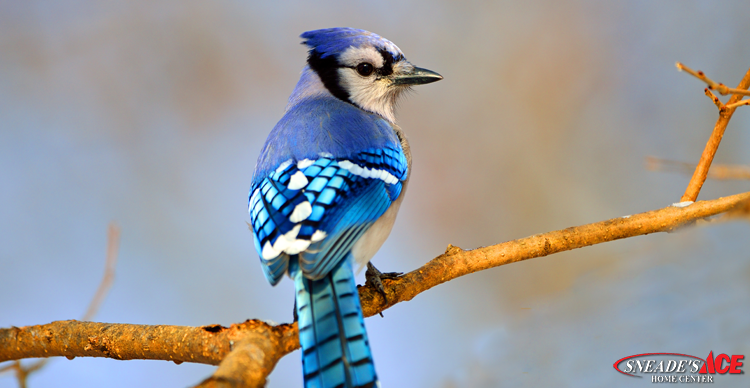
“Somewhere over the rainbow, Bluebirds fly.” That famous lyric from the “Wizard of Oz” helped immortalize the beautiful Bluebird. Since early colonial times, people have loved Bluebirds because of their beauty, their feeding in open areas around houses and farms, and their endearing habit of readily nesting in man-made boxes.
In the U.S. there are three different types of Bluebirds. The Eastern Bluebird that occurs East of the Rockes is by far the most numerous. Across the Western one-third of the U.S.A. you will also find Mountain Bluebirds and Western Bluebirds. One important thing to remember when providing housing for Bluebirds, is that you need to provide larger floor space and entrance holes in diameter for Western and Mountain Bluebirds. A 4″ by 4″ floor is adequate for Eastern Bluebirds, but a 5″ by 5″ floor is recommended for Mountain and Western Bluebirds. The entrance hole should be 1 1/2″ in diameter for Eastern Bluebirds, and 1 9/16″ for Mountain and Western Bluebirds.
All Bluebirds are cavity nesters. Once common in rural and suburban areas, Bluebird populations declined by as much as 90% from 1920 – 1970. The decline was due to two things: The loss of nesting habitats, such as tree holes, rotted out fence posts and old orchards; and the introduction of the Starling and House Sparrow in the last half of the 1800’s. These two species, introduced from Europe, competed heavily with the Bluebird for existing nesting cavities. Utilization of a Sparrow trap is often critical to Bluebird breeding success.
Now you too can make a contribution to conserving these beautiful birds by putting up nest boxes in an appropriate habitat. The key to attracting Bluebirds to nest in you yard is to have plenty of potential nesting locations, food, and water. Bluebirds do prefer more “open area” so if your yard is heavily wooded you’ll enjoy many other nesting birds, but probably not Bluebirds.
The female will lay four to five light blue eggs that will take thirteen to fifteen days to hatch. The male brings food to his mate and the young during the critical first few days of feeding. They act like tiny hawks, in their slumped hunting position, waiting patiently for an insect or beetle to show itself. It then pounces on it and brings the food back to the nest. Providing a T-shaped perching cross then to twenty yards in front of the next box can sometimes help attract Bluebirds. Add a Nest Lift to the bottom of your house. Keeps nests dry and safe! Helps control Blow flies, parasites and other nesting problems. Helps ensure more viable eggs hatch.
Bluebirds are “Family Role Models.”
Bluebird young will fledge in fifteen to twenty days. Even though the parents will keep feeding them, the fledglings can find their own food in about two weeks.
Some of the newly independent youngsters from the first brood are often seen bringing food to their new siblings. They teach us much about the “Bond and Love of Family.” This often continues into the fall and at times they stay together until the following spring. This is a great example of how we humans should support family members.
So, what are you waiting for? Get your houses up, Mealworms and water out, and sit back and watch for “Brilliant Blue to appear!”
